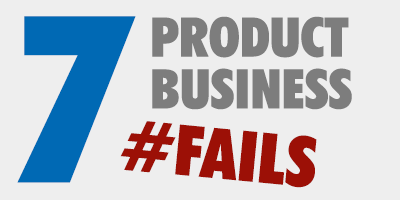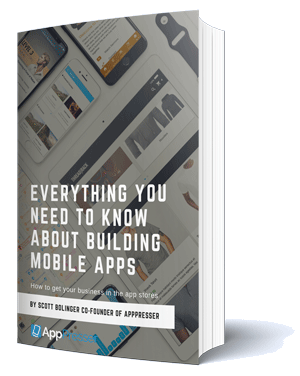7 Product Business Fails and How to Avoid Them

I’ve been selling products online for over five years now, and I’ve made my fair share of mistakes.
Product businesses have unique challenges, and if you aren’t aware of them it can hurt you as your business grows. Whether you are selling products now, or interested in what it’s like, I’m going to share some insights that may help you.
Fail #1: Not Knowing What You Are Getting Into
One of the reasons I got into the product business in the first place was because I enjoy building cool stuff. Unfortunately, selling products doesn’t mean you build stuff all day. As you grow, it becomes more business than coding.
Once you have a stable product and a little traction, marketing becomes more important than coding. Sure, you have to fix bugs and build new features, but your sales are going to be what drives everything. You have to get people to buy your product…or else you don’t have a business. As your team grows, you have more people to manage, and you go from maker to manager.
If you are a developer that wants to sell your products, learn about business and marketing. It will be more important to your company over the long term than your coding skills.
Fail #2: Picking the Wrong Business Model
You may look at another successful business like WooCommerce, which is a free core product plus paid extensions. Sounds good, so you copy their business model for your product.
It makes sense; you think the model is part of their success. This may be true, but that doesn’t mean it’s the right one for you. Something you may not realize about building a free product + extensions is that the free product causes tons of support headaches. Woothemes dealt with this for a long time (and they probably still are)–people who have paid them $0 are sending tons of support emails asking for help, or they purchase the cheapest extension, and then get support for the entire free product.
Another problem with the extensions model is that you end up with a ton of products to maintain and support. This is especially true if you also sell third party extensions. You don’t realize this is a problem until you have too many products, and you’ve grown so big that it is overwhelming.
Or let’s say you pick SaaS because you like the idea of recurring revenue. What you don’t realize is that making a SaaS means you have two products: the one you are selling and the SaaS infrastructure itself. You have to deal with onboarding, churn, hosting issues, downtime, and more.
I’m not saying any business model is bad in itself, but that they all have unique challenges. Research them and pick the one that works best for your product. Don’t just count on someone else’s successful model working for your business too, or you might find yourself in trouble!
Fail #3: Making Too Many Products
Before you launch, the only thing you are doing is building awesome products and features. You can get stuff done really fast, and you think that will continue after you launch. Wrong!
Once people start buying your product, you’ll have to factor in time spent on support–and fixing bugs that your customers come across. Fixing bugs takes ten times as long as building features, and your product isn’t any more appealing when you are done.
Then a new major release of WordPress comes out, or a third party service you integrate with changes their API. Now you have to spend time updating for those changes.
Let’s say you are so awesome that you built twenty different plugins. Go you!
The more products you have, the more bug fixing and updating you have to do. You may find yourself bogged down with bugs and then you’ll have no time to build new features or products without hiring more developers.
What’s also likely to happen is that two of your products will bring in 90% of your revenue. If you could sell those two products and get rid of the rest, you would be much more efficient and profitable.
Think about this before you build that next product or feature.
Fail #4: Thinking Support Is Not a Big Deal
Support is the hardest part of a product business, and you need to be prepared.
If you have even a mildly successful product that is somewhat complex, you may find yourself doing support all day every day at some point. Almost every founder has been there.
I know it’s hard to get everything done before launch, but do as much documentation as you can. I would recommend not using WordPress for this. It will quickly become unruly and difficult to manage! We use Helpscout Docs. Third party systems like this already have great search and design, so it requires no time from you to maintain. All you have to do is write the docs, and believe me, it is a huge time saver.
Don’t use a forum. There is a reason many of the big WordPress companies dropped them–it’s because they are huge headache to maintain. It’s difficult to keep track of what issues you need to reply to and when. Use a help desk instead. We use Helpscout, but some people prefer Zendesk because it has more features.
Your website can also answer questions for people, work on your site copy so you cut down the number of pre-sales emails you get. That leads me to the next fail…
Fail #5: Having a Crappy Website
I know firsthand that even if you have the skills to make a killer website, your own site often goes neglected.
There are so many other things to get done that your site is your last priority. If your site sucks, your sales will suffer.
Your site sells your product, so it has to be in tip-top shape. It’s ok to get something simple up so you can launch, but plan on putting some major work into it when things settle down. Pay a professional to do your site branding and design if you don’t have a good in-house designer. Good design builds trust and leads to more sales; it’s worth the money.
Work on your messaging, optimize for conversions, A/B test, and generally clean things up. This is an ongoing job–you don’t re-design your site and forget about it. It’s something you should be working on every week.
Make sure you have a solid payment system in place from the beginning. We use Easy Digital Downloads, but there are other great options out there. Depending on your business, consider not using a WordPress plugin for your payment system. Payments and email are two things that can be better handled off site for many businesses. (This is especially true for SaaS.)
Fail #6: No Marketing Plan
Your product won’t market itself and it takes a lot of time and effort to spread the word.
If you are a developer, you need a partner or employee that is really good at marketing. You won’t be able to build/maintain your code and do a great job at marketing at the same time. It’s ok to limp along in the beginning, but the sooner you start marketing the better. Marketing is like a snowball rolling downhill; it takes time, but once it gets going, watch out!
I’m a big fan of content marketing; it is a great way to increase traffic, build trust, and build your business. Check out the blog and guides on Quick Sprout for lots of great tips.
Email is another great place to start. Make sure you have a solid way to capture emails from potential visitors, which is usually a great piece of content like an ebook or email course. This should be something valuable on its own, not a sales pitch for your product.
Don’t use a WordPress plugin for email! Sending email from your own server is a terrible idea. We’ve used MailChimp for a while; plus, it’s free when you start. MailChimp is good for sending out emails, but you can get even more ninja with email–we recently started experimenting with Convertkit.
Convertkit and systems like it allow you to create email sequences after visitors opt-in, which can be a great way to build a relationship. You can send them great informational content, and even soft-sell your product. We use email sequences to introduce people to our product, and also send them setup information after they purchase.
I don’t have any hard data yet, but once this process gets fine-tuned I have no doubt it will increase our conversion rate.
Fail #7: Never Getting Started
The biggest fail for any entrepreneur is never launching because they are consumed by self-doubt, overthinking it, perfectionism, or procrastination. Get it done and get it out there.
There are challenges with any business, but that doesn’t mean it’s not worth doing. I love selling products, and I would do it all over again if I had the choice.
Avoid these fails if you can, but if you can only avoid one, make it #7.
In your experience, what is another product business fail? Let me know in the comments.


Great post. I agree with all your points. Specially the 4th one. “Thinking Support Is Not a Big Deal” not providing the tech support facility can harm the business, and its sales.